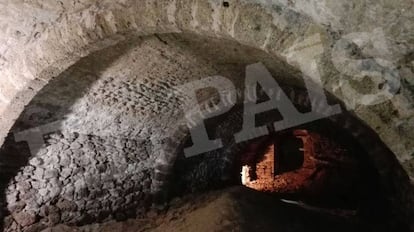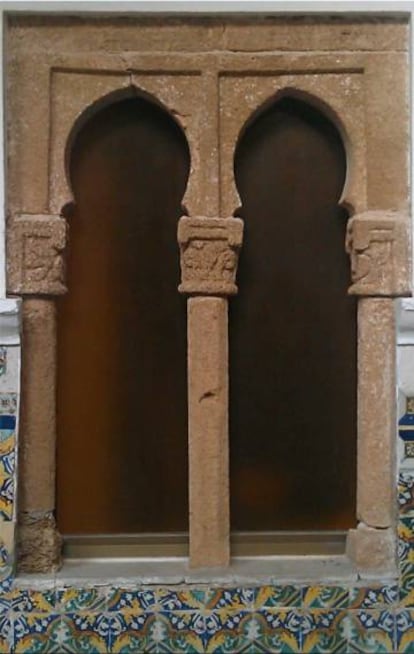What hides beneath the Virgen de Regla sanctuary in Chipiona?
The cellar under the current church has been identified as a 1,300-year-old place of worship for the Visigoths

When archeologist Antonio Ramos Millán realized what was beneath the Virgen de Regla church in Chipiona, Cádiz, he felt as though he had finally seen the light. A professor of prehistory and archeology at the University of Granada, he has concluded that the chamber below the current place of worship was once an ancient Visigoth temple dating back to the 7th century and subsequently recycled as a castle and a mosque for the Almoravids – a Berber dynasty. Given its history and state of conservation, Ramos believes the discovery to be unique.
Until now, it was believed that the monastery of Nuestra Señora de Regla began as a fort and a chapel donated in 1399 by Alonso Pérez de Guzmán, a Spanish nobleman and hero of Spain during the medieval period. But Ramos and his team argue that it dates back almost seven centuries earlier. Their reasoning is based on the study of two incongruous design aspects: a split window and a mysterious underground chamber whose purpose has always been unclear.
There are almost daily discoveries here
Antonio Ramos Millán, archeologist
“Its existence was known but nobody realized what it had been,” says Ramos, referring to the recent discovery. On the strength of Ramos’s theory, the Andalusian culture department is going to revise the site’s designation plans as a Cultural Interest Site, in order to incorporate the new findings.
Measuring 15 meters in length and 4.5 meters across, the underground chamber lies beneath the monastery that is joined to the 20th-century church. It is covered with a grand barrel vault with three semi-circular arches built around the 7th century. Inside, there is a drinking well beside an arched recess, used by the early churches to bury martyrs.

“It wasn’t a funeral crypt,” explains Ramos. “It was a place of worship, a legacy from the catacombs of the early Christians.” Ramos adds that the chamber was the lower floor of a two-floor Visigoth building used for monastic purposes.
The Franciscan monks who now inhabit the building have been aware of the chamber for some time. “It has been used as a wine cellar, a refuge and to hide the Virgen de Regla [statue] during the Civil War,” says Ramos. “It’s not that we have discovered that it is there but that we have discovered what it was.”
The same applies to the split window comprised of two horseshoe pointed arches that triggered the research 10 years ago. Until now, it was believed to be Mudejar in design – an art style that combined Muslim and Spanish art after the Reconquest.
However, Ramos believes the window to have been fashioned many years earlier as a feature of the upper floor of the Visigoth temple. The Mozarabs – Christians who lived under Arab rule – kept the chamber as a place of Christian worship until, at the start of the 12th century, the Almoravids took over Al-Andalus and exiled the Christians living in the south of Spain to the north of Africa. Subsequently, the building was turned into a castle or fort that incorporated a mosque and the window was redesigned to suit the Almoravids’ taste, according to Ramos’s theory.
“It was a symbolic window,” says Ramos, who adds that its significance also lies in the fact it confirms the existence of a fort that, although subsequently converted back into a place of Christian worship, has been almost perfectly conserved.
Alluding to the chamber’s earlier purpose, he says: “We don’t know of any Visigoth crypts that are still entirely whole – there’s just the obvious example of the part of the San Antolín crypt in Palencia Cathedral.”
This fragment of the past that provides a fuller historical picture is now to be incorporated into the site’s status as a place of cultural interest, though in the short term there are no plans to open it to the public. According to Ramos, the site is likely to throw up more secrets.
“There are almost daily discoveries here,” he says. That, of course, is to be expected from a place of worship that has been batted back and forth between religions over the course of 1,300 years. “In fact, the current Franciscan Order is heir to a thousand years of monastic tradition,” says Ramos.
English version by Heather Galloway.
Tu suscripción se está usando en otro dispositivo
¿Quieres añadir otro usuario a tu suscripción?
Si continúas leyendo en este dispositivo, no se podrá leer en el otro.
FlechaTu suscripción se está usando en otro dispositivo y solo puedes acceder a EL PAÍS desde un dispositivo a la vez.
Si quieres compartir tu cuenta, cambia tu suscripción a la modalidad Premium, así podrás añadir otro usuario. Cada uno accederá con su propia cuenta de email, lo que os permitirá personalizar vuestra experiencia en EL PAÍS.
¿Tienes una suscripción de empresa? Accede aquí para contratar más cuentas.
En el caso de no saber quién está usando tu cuenta, te recomendamos cambiar tu contraseña aquí.
Si decides continuar compartiendo tu cuenta, este mensaje se mostrará en tu dispositivo y en el de la otra persona que está usando tu cuenta de forma indefinida, afectando a tu experiencia de lectura. Puedes consultar aquí los términos y condiciones de la suscripción digital.
More information
Archived In
Últimas noticias
The new victims of the Republican war on Obamacare: Millions hit by soaring health insurance premiums
A country divided on migrant rights: Some US states expand protections while others restrict them
Venezuela authorizes the release of another 87 political prisoners
There is as much life left to discover on planet Earth as that which is already known
Most viewed
- David King, chemist: ‘There are scientists studying how to cool the planet; nobody should stop these experiments from happening’
- Reinhard Genzel, Nobel laureate in physics: ‘One-minute videos will never give you the truth’
- Oona Chaplin: ‘I told James Cameron that I was living in a treehouse and starting a permaculture project with a friend’
- Sinaloa Cartel war is taking its toll on Los Chapitos
- The Interoceanic Train, the Mexican alternative to the Panama Canal











































